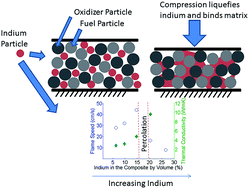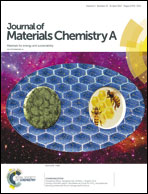Percolation of a metallic binder in energy generating composites†
Abstract
Indium is introduced here as a metallic binder in energetic composites as an approach for consolidating the media and providing a highly conductive percolating scaffold for enhancing energy transport. Indium can replace traditional polymer binders and provide an approach for not only binding composites but also enhancing energy transport. For energy generation applications, a commonly used formulation in thermal batteries is investigated and comprised of magnesium (Mg) and manganese dioxide (MnO2) powders mixed with varying indium (In) concentrations and pressed into thin sheets. Scanning electron microscopy (SEM) images indicated that during compression In flows through voids in the composite, resulting in a connected network of highly conductive filler. This network produces self-adhered composites that do not require additional binders. The thin sheets are ignited, flame speeds are measured, and specific energy ranged from 2000–5000 kJ kg−1 depending on the In concentration. Energy liberation is maximized for Mg + MnO2 mixed with 19 vol% In. Laser flash analyzer (LFA) thermal conductivity measurements demonstrate a good correlation between high energy propagation rates and optimal thermal conductivity. However, increased thermal conductivity is balanced by decreased heat production, and energy propagation decreased beyond 19 vol% In. Comparison of thermal conductivity measurements with predictions from classical and more recent percolation theories show that percolation in composites most closely aligns with the assumptions of the lattice percolation theory.



 Please wait while we load your content...
Please wait while we load your content...